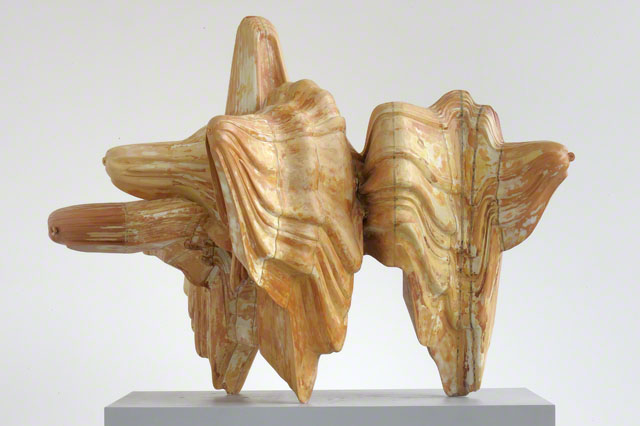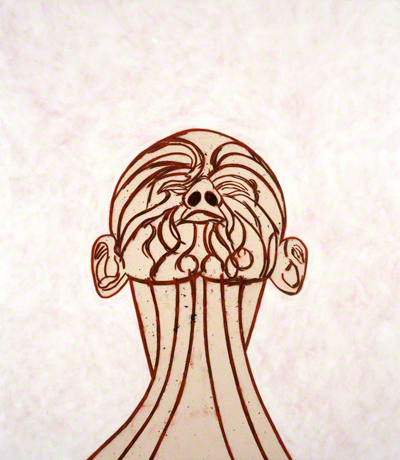Contemporary Responses
The exhibition includes artworks created after 1900 that represent a wide range of responses to the Character Heads by Messerschmidt. These works—by Bruce Nauman, Tony Bevan, and Cindy Sherman, among others—also reflect the continuing impact today of the aesthetic ideals and interest in expression established during the 18th-century European Enlightenment.
Modern and contemporary artists have been drawn to the Character Heads for their perceived departure from the confines of academic convention. But it is also the combination of a reductive style, refined modeling and carving, and exaggerated expression that make these sculptures evocative and familiar to modern audiences. The juxtaposition of works from different time periods illustrates the psychological power that Messerschmidt's Character Heads continue to exert over the contemporary viewer.
Modern and contemporary artists have been drawn to the Character Heads for their perceived departure from the confines of academic convention. But it is also the combination of a reductive style, refined modeling and carving, and exaggerated expression that make these sculptures evocative and familiar to modern audiences. The juxtaposition of works from different time periods illustrates the psychological power that Messerschmidt's Character Heads continue to exert over the contemporary viewer.
Tony Cragg
For English sculptor Tony Cragg, Messerschmidt's work "is not just representational but has also become a test for psychological responses and for unusual physical states of the face or for unusual facial expressions." Though highly abstracted, Cragg's sculpture is nonetheless rooted in a figurative tradition. In Mental Landscape he draws inspiration from the human face, and several heads morph into the larger, polymorphic structure whose silhouette assumes different aspects from multiple viewpoints. Profiles can be glimpsed emerging from the warmly colored, acrylic composite material, Jesmonite, offering serial comparisons with the profiles and silhouettes of the Character Heads.

Ernste Würden from the Messerschmidt Series, 1976–77, Arnulf Rainer (Austrian, born 1929). Overpainted photograph mounted on wood panel, 23 1/2 x 18 1/4 in. (59.7 x 46.4 cm). Private collection. © Arnulf Rainer
Arnulf Rainer
Arnulf Rainer conflated his own scribbles in oil stick over photographs of 19th-century plaster-cast reproductions of eight of Messerschmidt's Character Heads—an overt statement of the contemporary artist's enthusiasm for the 18th-century sculptor's oeuvre. Rainer called these images "conversations," through which he engaged directly with Messerschmidt's work.See all eight photographs in Arnulf Rainer's Messerschmidt Series »
This series forms part of a larger corpus of work that reflects the evolution of Austrian Expressionism, which first developed at the beginning of the 20th century. Also included in the exhibition is Rainer's series of twelve photographic self-portraits, Nervenkrampf, in which Rainer's face is distorted into various obscure grimaces.
- AUDIO: Curator Antonia Boström explains Rainer's engagement with Messerschmidt in his photographs.
Update Required
To play the media you will need to either update your browser to a recent version or
update your Flash plugin.

Self-Portrait after Messerschmidt, 2009, Tony Bevan (English, born 1951). Acrylic and charcoal on canvas, 104 x 90 1/4 in. (264.2 x 229.2 cm). Courtesy L.A. Louver, Venice, CA and Ben Brown Fine Arts, London. © Tony Bevan
Tony Bevan
For several decades, Tony Bevan has investigated his own image through self-portraiture, and in recent years these works have been interpreted in close relation to Messerschmidt's Character Heads. Bevan's fascination with the sculptor dates from his undergraduate years as an art student at Goldsmiths College in London, where he wrote a dissertation on the sculptor.This self-portrait is closely based on Messerschmidt's Second Beak Head, but by enlarging its scale and introducing a sharp perspective, it assumes monumental proportions that even further accentuate its sinister character.
- AUDIO: Learn more about Bevan's technique and his fascination with Messerschmidt's Character Heads.
Update Required
To play the media you will need to either update your browser to a recent version or update your Flash plugin.

